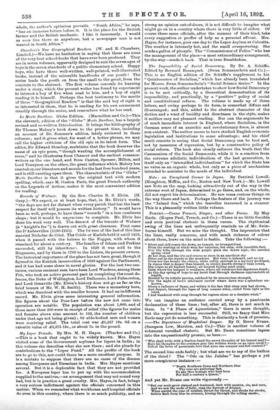Records of Walmer. By the Rev. Charles R. S. Elvin.
(H. Gray.)—We expect, or at least hope, that, in Mr. Elvin's words, "the days are not far distant when every parish that has the least respect for itself will possess its written history." It would have been as well, perhaps, to have these " records " in a less cumbrous shape; but it would be ungracious to complain. Mr. Elvin has done his work very well. The descent of the tenants of Walmer (a "knight's fee ") is drawn out with great clearness. First came the D'Aubervilles (1130-1245). The he'ress of the last of this line married Nicholas de Criol. The Criols or Keriels held it until 1413, when it passed with the heiress to the Fogges, with whom it remained for about a century. The families of Isham and Perkins succeeded, still by inheritanc3. In 1628 it was sold to the Hugessens, and by them in 1789 to the Listers, its present owners. The historical importance of the place has not been great, though it figured in the Kentish insurrection of 1648 against the Parliament, and it has had some share in naval glories. For the last two cen- turies, various eminent men have been Lord Wardens, among them Pitt, who took an active personal part in completing the coast de- fences, the Duke of Wellington, Lord Dalhousie, Lord Palmerston, and Lord Granville (Mr. Elvin's history does not go as far as the brief tenure of Mr. W. H. Smith). There was a monastery here, which was dissolved with the smaller houses. It had an indifferent record. Mr. Elvin gives some interesting general information. His figures about the Poor-Law before the new Act came into operation are notable. The population was about 1,800, and of these more than 200 were in receipt of relief (the figures for males and females above nine amount to 192, the number of children under that age not being given) ; 82 able-bodied men and women were receiving relief. The total cost was £1,257 188. 9d. on a rateable value of £3,375 15s., or about 7s. in the pound.
































 Previous page
Previous page